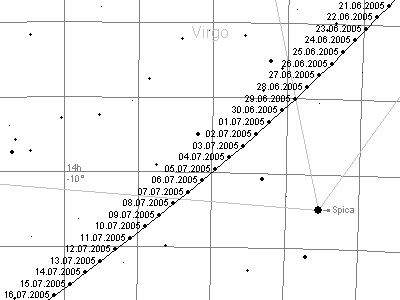|
Ground-Based Observations of Comet 9/P Tempel 1
|
|
|
It Takes a Cosmic Village
|
|
In preparation for the mission, professional and amateur astronomers have been observing Tempel 1 to provide as much data about it as possible. It may seem paradoxical to make observations before the mission, but to insure that the primary objectives are met, the science and mission teams have to know as much as possible about the comet so that they can design the mission, instruments, and spacecraft. How often do you go on vacation without double-checking the weather forecast? That's how the scientists use the information they gather - to help them better plan. Some of the things they can find out about the comet from careful observations are the amount and size of dust surrounding the comet, whether the comet is rotating and how, and the exact size of the comet.
And even after all the hardware is designed and built, the Deep Impact team will continue to use the Ground-Based Observations to make sure the comet continues to do what they expect it to do. The Ground-Based Observations will be particularly important during the impact and afterwards as they will complement the data taken by the spacecraft.
So who is making the observations? From where?
-
Large Ground and Space-based Telescope Observatories
Astronomers who want to obtain data from large telescope (over 1 meter in aperture) observatories must apply for observing time. If their project is approved, the facility will grant observing time - how many nights depends on the project, often it is only a few nights. Unfortunately, there is no guarantee for the weather. Deep Impact's science team must go through the same process as other astronomers to obtain observing time on the large telescopes. Dr. Karen Meech coordinates these ground- and space-based observations. The goal of the program is to have baseline observations of the comet's activity, including outgassing of volatiles and development of the dust coma, to compare with the observations taken during and after encounter. -
Small Telescope Science Program (STSP)
Because time on the larger telescopes is hard to get and usually very short, Deep Impact organized a program to fill in the gaps in observations by asking for help from small telescope observers. Most of these small telescope observers are amateurs who are technically proficient. They have an advantage over the larger observatories in being able to observe an object for a longer time and on a repeated basis. In addition, these observers are located throughout the world, providing the opportunity for longitudinal coverage of the comet, important for determining the rotation period. The first observing campaign ran from February 2000 through March 2001, after which the comet became too faint to observe. The program relaunched in late 2004 when the comet returned and brightened. Images of Tempel 1 obtained by the STSP observers can be found here. -
Amateur Astronomers
Opportunities exist for everyone to observe the comet. Tempel 1 reached aphelion (the point in its orbit most distant from the sun) in late 2002. It is slowly heading back towards perihelion but is still very dim. Most amateurs will not likely see it until early 2005. You can check out Tempel 1's current position and orbit on the Near-Earth Object website. At first it will be very dim, but it will slowly brighten. Material will be provided on this site to help you find and observe the comet yourself. In addition, the mission will provide information to astronomy clubs so that they can organize comet watches for their local communities. So keep checking back for updated information.
Finder Charts for 9P/Tempel 1
 |
The target of the Deep Impact mission comet Tempel 1 is not a bright comet. For most of the spring, it will be difficult to see even in binoculars. However, we hope that observers will challenge themselves and try to observe the comet and so we provide these finder charts. If you do not have a telescope, please check with your local astronomy club or observatory for observing sessions. Take along one of these charts or reference the staff to these pages. You might also want to take a look at our Amateur Observer pages to learn more about observing Tempel 1 and if you are an advanced observer, please visit the STSP site to learn how to contribute images.
- chart covering 17Dec2004 to 12Feb2005
- chart covering 12Feb2005 to 12Mar2005
- chart covering 12Mar2005 to 16Apr2005
- chart covering 16Apr2005 to 05Jun2005
- chart covering 05Jun2005 to 10Aug2005
- chart covering 10Aug2005 to 01Oct2005
Charts generated by Gregario Drayer.
Music to my ears, uh, I mean - my instruments!
The science team won't just point an instrument at Comet Tempel 1 during impact and catch whatever data comes their
way. There has to be a very specific sequence set to gather data and it is a little like a symphony. Read Dr. Lucy
McFadden's comparison of the two here.











